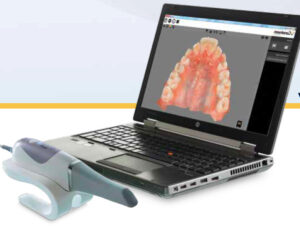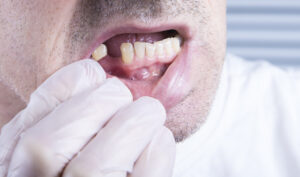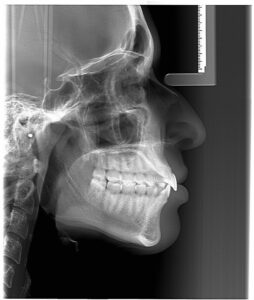Header logo
header top contact widget
Asheville Periodontist
Ages 65 & Over: Stay More Socially Involved With A Healthy Smile.
Posted on Feb 09, 2022 by William J. Claiborne, DDS MS
Science has shown that the act of smiling gives a boost to our mood. Even a “fake” smile triggers endorphins (feel-good chemicals) in the brain to release, providing a bit of a “natural high.”
There are many things that make us smile. Time spent with friends, family, and social activity are helpful in keeping an individual active and involved, and hopefully smiling. Unfortunately, older adults are more prone to social isolation. This has proven to be unhealthy, mentally, physically and yes, even for the health of a smile.
Older adults are already at a disadvantage when it comes to having a healthy, full smile. Some estimates show that over one-quarter (26 percent) of adults ages 65 and older have 8 or less remaining natural teeth. About 17 percent in this same age category are missing all of their teeth.
On a positive note, total tooth loss (being “fully edentulous”) in the 65 or older category is decreasing. When comparing the 5-year periods of 1999–2004 to 2011–2016, it dropped by nearly 30 percent.
However, tooth loss comes with many frustrations, and even embarrassment. Many adults who wear dentures or partial dentures to replace missing teeth have similar complaints: sore spots on tender gum tissues, difficulty biting or chewing, slips while speaking or laughing, discomfort and the fear of embarrassment.
These frustrations often lead to (1) a change in diet; and (2) less social involvement. When certain foods become too difficult to chew properly, adults often alter their diet, opting for softer foods that dissolve easily in the mouth. Unfortunately, these foods typically lack in protein and fiber needed for good health.
Too, improper chewing is challenging to the digestive system. It is no wonder that denture wearers have more gastrointestinal problems and take more medications than people who still have their natural teeth.
Social isolation and loneliness have been linked to numerous measures of health and well-being. One interesting study focused specifically on the effects of social isolation and loneliness in relationship to oral health.
The Chinese Longitudinal Healthy Longevity Survey was conducted in three time segments: 2011-12, 2014 and 2018. The purpose of the study was to asssess the effects of social isolation and loneliness on the rate of tooth loss.
Data of the survey was evaluated, with nearly 4300 adults 65 and older who were participants in at least two of the time segments. The findings showed that, as tooth loss increased, so did social isolation. This study provided strong evidence that social isolation was associated with fewer remaining teeth and even accelerated the pace of tooth loss.
This problem is not just one of our current 65+ age group. According to the U.S. Census, the number of American adults aged 65 years or older is expected to reach 98 million by 2060, making up nearly one-quarter of the overall population. This means that a 30-year-old today will be well within this age group in less than 40 years.
Currently, the poorest oral health in Americans 65 and over are those who are economically disadvantaged, have no insurance, smoke, and in racial and ethnic minorities. Additional factors are being disabled, homebound, or who live in nursing homes. After retirement, some adults lose insurance benefits and find that Medicare does not cover routine dental care.
A high percentage of older adults also have periodontal (gum) disease, the nation’s leading cause of adult tooth loss. Nearly 68 percent of adults aged 65 years or older have some level of gum disease. While nearly 1 in 5 older adults have lost all of their teeth, total tooth loss is twice as prevalent for adults ages 75 and older compared with the 65-74 age group.
Aging also increases the likelihood of developing oral cancer. Oral and pharyngeal cancers are primarily diagnosed in older adults at a median age of 62 years. Gum disease also increases risks of chronic diseases including arthritis, diabetes, heart disease, and stroke.
All of these challenges are why a periodontist can be instrumental in the health and well-being of adults, especially those in the “older” age groups.
A periodontist is a dental specialist who receives 4 years of undergraduate training at a college or university and goes on to earn a dental doctorate. After 4 years of dental school, they further their education for another 3-4 years before completing stringent requirements for a specialty certification in periodontics.
A periodontist begins by accurately diagnosing the stage of gum disease present, or if it does exist. Many people are surprised by its presence since it can exist without obvious signs or symptoms.
From there, we develop a customized treatment plan based upon factors such as the patient’s current overall health, their diet, medications, whether they smoke or drink alcohol, and their age. We also discuss sedation options if dental fear is a concern.
Treatment recommendations are made based on what will effectively resolve existing problems without over-treating or under-treating. By restoring the patient to good oral health, we are able to help many avoid tooth loss and rid their mouths (and thus, their bodies) from an overload of oral bacteria.
Periodontists also specialize in the diagnosis and placement of dental implants. They are trained to understand all the intricate concepts involved in selecting the proper type of implant. Additionally, they are skilled at placing implants at proper depths and angles. As they oversee your “healing” time, periodontists are able to optimize your comfort and outcome.
When tooth loss begins, replacing that tooth with a dental implant is highly advised. Dental implants are designed to last a lifetime and restore biting and chewing comfort and stability. Additionally, the stimulation they provide to the jaw bone helps to halt bone loss.
This is because the implanted portion, held by the jaw bone, recreates the presence of the natural tooth roots you once had. While a denture or partial is positioned on top of the gum tissues, dental implants have the advantage of the jaw bone as their foundation, just as natural teeth.
For those who feel they are “too old” for dental implants, many of our implant patients are well into their 80’s or 90’s. Keep in mind that today’s adults are staying in the workplace longer, staying active in senior years, and living longer. Since 1950, Americans added over 11 years to average life expectancy, to age 79, according to 2019 statistics.
At every age, your smile reflects you, and should be a positive reflection throughout your lifetime. If you are experiencing tooth loss, let’s discuss halting the process during a consultation appointment in our comfortable Asheville periodontal dental office.
Call 828-274-9440 to schedule an appointment.
https://www.cdc.gov/oralhealth/basics/adult-oral-health/adult_older.htm
Optimize Your Dental Implant Experience, Results.
Posted on Jan 24, 2022 by William J. Claiborne, DDS MS
I recently had to return a small appliance at a “big box” store. I didn’t have the receipt but hoped I could at least get a store credit. When I explained this to the customer service rep, she said a receipt wasn’t necessary. She scanned the bar code and asked me if I wanted the refunded amount applied to the credit card I used to purchase it. No receipt needed, no credit card, and I was in and out of the line in no time.
With today’s technology, many processes that were once time-consuming and complicated are now simple and “painless.” Less time is required with better results. Technology has made this true, too, in dentistry.
As a periodontist, I specialize in the prevention, diagnosis, and treatment of all stages of periodontal (gum) disease. I also have advanced training and skills in the selection and placement of dental implants. In addition, periodontists are particularly skilled in performing cosmetic periodontal procedures.
As an Asheville periodontal specialist for over 30 years, I’ve treated a variety of needs that involve the gum tissues. These include:
– Treatment of all stages of gum disease (gingivitis, pregnancy gingivitis, periodontal disease, periodontitis)
– Reshaping gum tissues for esthetic enhancement (crown lengthening, gingivectomy for ‘gummy smiles’, repairing areas of gum recession)
– Diagnosis and placement of dental implants
– Treatment of lesions or cysts in oral tissues
To receive the extensive, additional 3 years of training after dental school to become a periodontist, (I believe) an individual must be passionate about the specialty. I certainly am, which is why I’m so committed to stay on top of the latest developments in the field.
This includes incorporating some of the most advanced technology available for the betterment of our Western North Carolina patients.
Our periodontal dental office features cutting edge technology, much of which is not available in other dental or periodontal offices in this region. These features help to diagnose with precision, treatment plan with superior accuracy and reduces the patient’s treatment time while optimizing comfort.
For our dental implant patients, these options have been significantly beneficial in maximizing results. Some specifically helpful in dental implant diagnosis and planning are:
LANAP With PerioLase MVP 7 – Laser-Assisted New Attachment Procedure is an advanced protocol that efficiently and effectively treats advanced gum disease with the added advantages of a dental laser. For patients who are preparing for dental implant placement, resolving gum disease prior to treatment is mandatory. LANAP offers a non-surgical alternative for patients with moderate to severe periodontal disease with very little discomfort and a quick recovery time.
Cone Beam Imaging – These amazing 3D “x-rays’ are ideal for diagnosing and treatment planning. The highly-detailed images provide a clear view of the upper and lower jaw. Because cone beam radiographs show sagittal, axial, and coronal planes, locating and tracking nerve canals optimizes implant placement. The images are captured in a quick, painless process and at minimal levels of radiation.
CareStream Cone Beam Computer Tomography Imaging – This enhanced tomography works with 3D imaging for exceptional detail and range.
Computerized Dental Implant Placement – This system provides the futuristic ability to position dental implants before the process actually begins. Through computerized technology, the implants are selected and “ideally positioned” on a 3D model of the patient’s jaw. From this, a template is developed for optimal treatment success, even for complex cases.
CS 3600 Intraoral Scanner – Rather than make impressions with bulky, goopy trays, this scanner quickly and comfortably captures digital impressions accurately and easily. These are used to create precision models or appliances (dental implant crowns, bridges, or full arches). The scanner can also reach hard–to–access areas in the patient’s mouth for superior results with improved patient comfort.
Sedation – Our Asheville periodontal practice is known for its environment of comfort and respectful care. We understand that over 70 percent of the adult population have some level of dental fear or anxiety. For optimal comfort and relaxation, we offer several sedation options, including oral and IV sedation.
Oral sedation is a pill that helps patients relax. It also has an amnesiac effect, leaving most with little or no memory of treatment afterward.
I.V. sedation (also known as ‘twilight sleep’) places the patient in a deeper sleep state and erases memory of the procedure. It is administered by a Medical Doctor (MD) who is a board certified Anesthesiologist.
With both sedation options, patients are closely monitored with advanced safety equipment throughout treatment.
When it comes to placement of dental implants, a periodontist has a unique understanding of the tender layers of gum tissues. Using gentle and precise skills when it comes to any treatment involving oral tissues, the patient experiences less disruption and incisions. When it comes to the gums, less is definitely more. We strive to optimize comfort levels and speed the healing process.
If you are considering dental implants, you may wish to begin with a consultation appointment. During this time, we can explain the vast difference in comfort, treatment time, and success available through our specialized skills and extensive technology.
Call 828-274-9440 to schedule. New patients are always welcome and a referral is not required.
The Hazards of Vaping Now Include Bone Health
Posted on Jan 12, 2022 by William J. Claiborne, DDS MS
If you’ve switched to vaping (e-cigarettes) as a “safer” alternative to smoking cigarettes, you may have heard that researchers have found this to be a misleading claim, in many regards.
Based on a study published in the American Journal of Preventive Medicine, people who vape have higher risk of developing asthma and chronic obstructive pulmonary disease (COPD). The European Journal of Preventive Cardiology also reports an increased risk of heart problems. Further, the American Lung Association warns that vaping causes a potentially higher cancer risk due to their dangerous mix of chemicals, including acrolein. (Acrolein is toxic to humans when inhaled, resulting in irritation to the upper respiratory tract.)
Now, another health risk has been revealed through research: bone health. In a study of over 5,500 adult users of e-cigs, it was noted that electronic cigarettes may be detrimental to bone health, even in young people. The study, published in the American Journal of Medicine Open, found that people who vape had a 46 percent greater rate of bone fractures.
To make matters worse, the study also found that people who vape in addition to smoking cigarettes have a greater fracture risk than those who are conventional smokers only.
A review in Bone Biology suggests there is negligible difference between vaping and cigarette use when it comes to bone health. It showed that nicotine exposure, regardless of the source, impairs the production of essential cells. Add to that the flavoring chemicals in e-liquids (often known as vaping juice), which are suspected to alter the body’s ability to form new bone.
https://www.thehealthy.com/addition/smoking/does-vaping-affect-your-bone-health/
How this occurs has to do with the inflammatory effects of the nicotine. To retain strength and mass, bones need a sufficient supply of minerals (such as calcium and phosphorus) and nutrients (such as vitamin D). In-depth research published by the European Journal of Clinical Nutrition revealed that smoking interferes with how the bones absorb these essentials. The result is the body’s reduced ability to maintain skeletal strength.
What is frustrating is that vaping hit the market touting itself as a “safer” option than tobacco cigarettes. In 2019, the U.S. Food & Drug Administration took issue with these claims, especially those by the vape pen manufacturer Juul, who marketed its product as a “modified risk” tobacco product, although research did not exist to back its “safer” claim. To the contrary, as research digs deeper and deeper into the risks associated with vaping, data continually stacks up as anything but.
Certainly, there are other contributing factors to compromised bone health. These include:
• Heavy alcohol use
• Being inactive
• A diet low in nutrients like calcium, phosphorus, and vitamin D
• Excessive dieting
Age, menopause, and having a family history of osteoporosis also affect your risk. Too, people with medical conditions (such as hyperthyroidism or anorexia), or taking medications (such as long-term corticosteroids) have a higher risk of bone thinning.
As a dental specialist, the findings associated with bone health are particularly concerning because teeth are enamel-covered bones that protrude above the gum line. Teeth are anchored by bone sections below the gum (tooth roots) and embedded into more bone – the upper or lower jaw bones.
For those who want to quit smoking and have turned to vaping as an aid, the odds aren’t good for successful results. Researchers found that among Americans who’d recently quit smoking, those who were using e-cigarettes were just as likely to relapse in the next year as non-users were.
Findings of one study reported that not only does vaping fail to help former smokers abstain from traditional cigarettes, the risk of relapse was actually slightly higher.
In order to maintain good oral health, it is especially important for smokers and vapers to be committed to a thorough at-home oral care regimen. This includes twice daily brushing, daily flossing and drinking plain water throughout the day. To combat dry mouth, consider using an oral rinse that is specifically formulated to replenish moisture (available OTC).
This should be coupled with having regular dental checkups and cleanings, starting with an examination by a periodontal specialist. A periodontist is a dentist who has received advanced training in the diagnosis and treatment of all stages of gum disease as well as in the placement of dental implants.
Symptoms of gum disease include tender gums that may bleed when brushing, swollen gums that turn red in color, receded gums, and persistent bad breath. As gum disease worsens, pus pockets can form on the gums at the base of teeth and the gum tissues become spongy. Teeth may loosen and may require removal.
Because the initial symptoms of gum disease are not always obvious, a periodontist can determine if gum disease does exist. If it does, he or she can discuss the most conservative treatment necessary to restore your gums to good health and then develop a program to help keep them so.
Our goal is to help each patient achieve a healthy smile for life. For patients who wish to achieve this, we work with each according to individual needs. Through a customized treatment plan, your oral health can be a positive part of your overall health. Call 828-274-9440 for an appointment.
Cracked & Broken Teeth A ‘Sign of the Times’
Posted on Jan 06, 2022 by William J. Claiborne, DDS MS
As a periodontist in Asheville NC for over 25 years, I’ve seen my fair share of teeth that have been removed or need removal. Most of these teeth, based on national statistics, are lost due to damage caused by periodontal (gum) disease.
Yet, in more recent years, I’m seeing people lose teeth due to broken or fractured teeth.
In my dental specialty, I have advanced skills in the treatment of gum disease as well as in the diagnosis and placement of dental implants. As the ideal option in tooth replacement, dental implants restore the stability and dependability of natural teeth.
So, it stands to reason that a lost tooth is best replaced by a dental implant. But, why are more and more individuals losing teeth due to fractured, cracked or split teeth?
It’s becoming more common to hear that dentists are treating more cracked teeth since the beginning of the pandemic. A recent survey shared by the American Dental Association (ADA) reported that over 70 percent of dentists surveyed (nearly 2300) saw an increase in patients who had experienced night-time clenching and grinding of teeth, or ‘bruxing’. These problems have typically been the result of bite misalignment, which interferes with the harmonious congruity of upper and lower teeth while eating or speaking.
When a tooth breaks or fractures below the gum line, it requires removal (in most cases) since the above-the-gum structure is generally insufficient to support a crown. As a periodontist, another area of the periodontal specialty is crown lengthening.
This procedure is often performed prior to the placement of crowns to correct the height of the gum arch that borders teeth. This is especially common for patients who have a ‘gummy smile,’ or too much gum area visible above upper teeth when in a full smile.
However, in cases where a tooth breaks, crown lengthening is sometimes performed to alter the surrounding gum tissues and expose enough tooth structure to support a crown. The benefit of this is the patient is able to avoid having the tooth removed and endure the many decisions (and costs) involved to replace it.
Pandemic stress, quarantine fatigue, mask burnout, a succession of variants, less social involvement, and general stress overload has become a global problem. Although stress is experienced by different people in different ways, it is not uncommon for it to be revealed through dental issues.
Many people hold stress and tension in their jaw muscles and jaw joints. This is why, during relaxation phases in a yoga class, it’s common for the instructor to encourage participants to relax their jaw muscles. Since the onset of the COVID-19 pandemic, stress is causing an unusually higher rate of oral health problems.

Based on the ADA survey, about 60 percent of responding dentists shared an increase in patients who clearly cite stress as the culprit for tooth damage. Thus, dentists have seen significant increases (up 63 percent) in chipped teeth, and about the same percentage of increases for cracked teeth and temporomandibular joint (TMJ) disorder symptoms, which includes headaches and jaw pain.
If you are experiencing problems regarding stress held in the jaw joints, here are a few tips that may help lessen the load:
• Walk away from the computer an hour before bedtime.
• Relax with a warm shower or play soothing music.
• Relax your jaw joints by putting your lips together, teeth apart, and resting your tongue behind front teeth or the roof of the mouth.
• Ask your dentist about a custom-designed night guard to protect your teeth from night-time clenching or grinding.
If the worst has occurred – losing a natural tooth – the best way to replace it is with a dental implant.
Dental implants recreate stimulation to the jaw bone, thereby halting the pace of bone loss. When bone mass is maintained, neighboring teeth have a reduced risk for being lost as well. Because dental implants are held in the jaw bone, they are also able to restore a natural biting strength with dependable stability.
There are many advantages to having dental implants, including the longevity. When dental implants are properly selected, placed and maintained, they should last your lifetime. This is why it’s so important to have your implant treatment through a Periodontist.
A periodontal specialist has advanced training and skills in the diagnosis and placement of all types of dental implants. He or she can enhance your ability to enjoy this superior tooth replacement option for a lifetime of confident, healthy smiles.
In our beautiful Asheville periodontal dental office, we offer the most advanced technology in dentistry. Additionally, oral and IV sedation (‘twilight sleep’) are also available for optimal patient comfort.
To learn more, call 828-274-9440. If preferred, you can begin with a consultation appointment. New patients are always welcome and a referral is not needed.
Recent Posts
Categories
Archives
- September 2024
- August 2024
- July 2024
- June 2024
- May 2024
- April 2024
- March 2024
- February 2024
- January 2024
- December 2023
- November 2023
- October 2023
- September 2023
- August 2023
- July 2023
- June 2023
- May 2023
- April 2023
- March 2023
- February 2023
- January 2023
- December 2022
- November 2022
- October 2022
- September 2022
- August 2022
- July 2022
- June 2022
- May 2022
- April 2022
- March 2022
- February 2022
- January 2022
- December 2021
- November 2021
- October 2021
- September 2021
- August 2021
- July 2021
- June 2021
- May 2021
- April 2021
- March 2021
- February 2021
- January 2021
- December 2020
- November 2020
- October 2020
- September 2020
- August 2020
- July 2020
- June 2020
- May 2020
- April 2020
- March 2020
- February 2020
- January 2020
- December 2019
- November 2019
- October 2019
- September 2019
- August 2019
- July 2019
- June 2019
- May 2019
- April 2019
- March 2019
- February 2019
- January 2019
- December 2018
- November 2018
- October 2018
- September 2018
- August 2018
- July 2018
- June 2018
- May 2018
- April 2018
- March 2018
- February 2018
- January 2018
- December 2017
- November 2017
- October 2017
- September 2017
- August 2017
- July 2017
- June 2017
- May 2017
- April 2017
- March 2017
- February 2017
- January 2017
- December 2016
- November 2016
- October 2016
- September 2016
- August 2016
- July 2016
- June 2016
- May 2016
- April 2016
- March 2016
- February 2016
- January 2016
- December 2015
- November 2015
- October 2015
- September 2015
- August 2015
- July 2015
- June 2015
- May 2015
- April 2015
- March 2015
- February 2015
- January 2015
- December 2014
- November 2014
- October 2014
- September 2014
- August 2014
- July 2014
- June 2014
- May 2014
- April 2014
- March 2014
- February 2014
- January 2014
- December 2013
- November 2013
- October 2013
- September 2013
- August 2013
- July 2013
- June 2013
- May 2013
- April 2013
- March 2013
- February 2013
- January 2013
- December 2012
- November 2012
- October 2012
- September 2012
- August 2012
- July 2012
- June 2012


